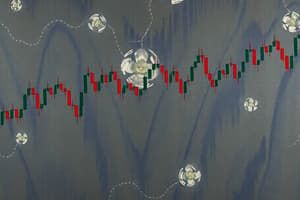Podcast
Questions and Answers
Which pattern is classified as a bullish reversal pattern?
Which pattern is classified as a bullish reversal pattern?
- Ascending Triangle
- Double Top
- Rising Wedge
- Triple Bottom (correct)
Which of these patterns indicates a bearish continuation?
Which of these patterns indicates a bearish continuation?
- Bullish Flag
- Inverted Cup & Handle
- Bearish Pennant (correct)
- Rounded Bottom
What type of pattern is an Inverse Head & Shoulders?
What type of pattern is an Inverse Head & Shoulders?
- Bullish Continuation
- Bearish Continuation
- Bullish Reversal (correct)
- Bearish Reversal
Which pattern represents a bearish reversal?
Which pattern represents a bearish reversal?
Which of the following is an example of a bullish continuation pattern?
Which of the following is an example of a bullish continuation pattern?
Which pattern does not fall under the category of bullish continuation patterns?
Which pattern does not fall under the category of bullish continuation patterns?
What type of pattern is specifically known for indicating a bullish reversal?
What type of pattern is specifically known for indicating a bullish reversal?
Which of these patterns represents a bearish reversal signal?
Which of these patterns represents a bearish reversal signal?
Identify the pattern that typically signals a bearish continuation.
Identify the pattern that typically signals a bearish continuation.
Which of the following patterns is categorized as a bullish pattern?
Which of the following patterns is categorized as a bullish pattern?
Flashcards
Triple Bottom
Triple Bottom
A chart pattern where the price touches the same support level three times. It is a bullish signal potentially indicating a change from a downtrend to an uptrend.
Triple Top
Triple Top
A chart pattern where the price touches the same resistance level three times. It is a bearish signal potentially indicating a change from an uptrend to a downtrend.
Inverse Head & Shoulders
Inverse Head & Shoulders
A chart pattern that looks like an upside-down 'Head & Shoulders' pattern, with a low point in the middle and two higher points on either side. It is a bullish signal potentially indicating a change from a downtrend to an uptrend.
Double Bottom
Double Bottom
Signup and view all the flashcards
Pennant
Pennant
Signup and view all the flashcards
Rounded Bottom
Rounded Bottom
Signup and view all the flashcards
Flag
Flag
Signup and view all the flashcards
Head & Shoulders
Head & Shoulders
Signup and view all the flashcards
Rounded Top
Rounded Top
Signup and view all the flashcards
Double Top
Double Top
Signup and view all the flashcards
Study Notes
Chart Patterns Cheat Sheet
- Chart patterns are used by technical analysts to identify potential reversals or continuations in price trends.
- Chart patterns are classified into two main categories: reversal and continuation.
- Reversal Patterns are used to identify a potential change in the direction of the trend:
- Bullish Reversal Patterns: indicate that the price is likely to move higher.
- Bearish Reversal Patterns: indicate that the price is likely to move lower.
Reversal Patterns
- Triple Bottom: a bullish reversal pattern that occurs when the price touches the same support level three times, forming three distinct bottoms.
- Double Bottom: a bullish reversal pattern that occurs when the price touches the same support level twice, forming two distinct bottoms.
- Inverse Head & Shoulders: A bullish reversal pattern formed when the price makes three distinct peaks with the middle peak (the "head") being higher than the two outer peaks (the "shoulders").
- Rounded Bottom: a bullish reversal pattern that occurs when the price forms a rounded bottom in a downtrend.
- Triple Top: a bearish reversal pattern that occurs when the price touches the same resistance level three times, forming three distinct tops.
- Double Top: a bearish reversal pattern that occurs when the price touches the same resistance level twice, forming two distant tops.
- Head & Shoulders: a bearish reversal pattern formed when the price makes three distinct peaks with the middle peak (the "head") being higher than the two outer peaks (the "shoulders").
- Rounded Top: a bearish reversal pattern that occurs when the price forms a rounded top in an uptrend.
Continuation Patterns
- Continuation Patterns are used to identify a potential continuation of the current trend:
- Bullish Continuation Patterns: indicate that the price is likely to continue moving higher.
- Bearish Continuation Patterns: indicate that the price is likely to continue moving lower.
Continuation Patterns
- Cup & Handle: A bullish continuation pattern formed when the price forms a "cup" and then a "handle".
- Inverted Cup & Handle: A bearish continuation pattern formed when the price forms an "inverted cup" and then a "handle".
- Ascending Triangle: a bullish continuation pattern that occurs when the price is contained between an upward sloping resistance line and a horizontal support line.
- Descending Triangle: a bearish continuation pattern that occurs when the price is contained between a downward sloping resistance line and a horizontal support line.
- Bullish Symmetrical Triangle: A bullish continuation pattern formed when the price is contained between two converging trend lines.
- Bearish Symmetrical Triangle: A bearish continuation pattern formed when the price is contained between two converging trend lines.
- Bullish Pennant: A bullish continuation pattern formed when the price has a sharp price move, followed by a consolidation phase that resembles a pennant.
- Bearish Pennant: A bearish continuation pattern formed when the price has a sharp price move, followed by a consolidation phase that resembles a pennant.
- Bullish Flag: A bullish continuation pattern formed when the price has a sharp price move, followed by a consolidation phase that resembles a flag.
- Bearish Flag: A bearish continuation pattern formed when the price has a sharp price move, followed by a consolidation phase that resembles a flag.
- Falling Wedge: a bullish continuation pattern that occurs when the price is contained between two converging resistance lines.
- Rising Wedge: a bearish continuation pattern that occurs when the price is contained between two converging support lines.
Reversal Patterns
- Reversal patterns show a potential change in the trend of the stock price.
- Bullish Reversal Patterns suggest the price is about to go up.
- Bearish Reversal Patterns suggest the price is about to go down.
Continuation Patterns
- Continuation patterns show a potential pause in the trend of the stock price.
- Bullish Continuation Patterns suggest the price will continue to go up.
- Bearish Continuation Patterns suggest the price will continue to go down.
Bullish Reversal Patterns
- Triple Bottom: Looks like a "W" formation, with three troughs at the same price level.
- Double Bottom: Looks like a "U" formation, with two troughs at the same price level.
- Inverse Head & Shoulders: The "head & shoulders" pattern upside down, with a high point in the middle and two lower points on either side.
- Rounded Bottom: A gradual, rounded upward movement, resembling a "U" shape
- Falling Wedge: Two converging trendlines that slope downward (like a wedge), indicating a change from a downward trend to an upward one
Bearish Reversal Patterns
- Triple Top: Looks like an "M" formation, with three peaks at the same price level.
- Double Top: Looks like an "M" formation, with two peaks at the same price level.
- Head & Shoulders: The "head & shoulders" pattern, with a high point in the middle and two lower points on either side.
- Rounded Top: A gradual, rounded downward movement, resembling an "inverted U" shape
- Rising Wedge: Two converging trendlines that slope upward (like a wedge), indicating a change from an upward trend to a downward one
Bullish Continuation Patterns
- Cup & Handle: A rounded "cup" shape followed by a brief downward "handle" before the price rises again.
- Ascending Triangle: A triangle formed by two trendlines sloping upwards, suggesting a pause before continuing to rise.
- Bullish Symmetrical Triangle: A triangular shape with converging trendlines, but the slope isn't as steep as the Ascending Triangle.
- Bullish Pennant: A short-term pattern that resembles a "flag" with a narrow range of price action.
- Bullish Flag: Similar to the Pennant, with a rectangular shape, indicating a pause before continuing the upward trend.
Bearish Continuation Patterns
- Inverted Cup & Handle: Looks like a "Cup & Handle" but upside down.
- Descending Triangle: A triangle formed by two trendlines sloping downwards, suggesting a pause before continuing to fall.
- Bearish Symmetrical Triangle: A triangular shape with converging trendlines, but the slope isn't as steep as the Descending Triangle.
- Bearish Pennant: A short-term pattern that resembles a "flag" with a narrow range of price action.
- Bearish Flag: Similar to the Pennant, with a rectangular shape, indicating a pause before continuing the downward trend.
Studying That Suits You
Use AI to generate personalized quizzes and flashcards to suit your learning preferences.




